Machine Learning Data Scientiest Resume Examples
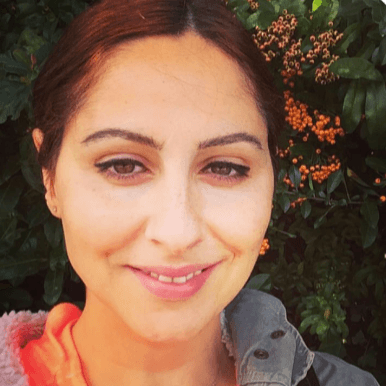
Jul 18, 2024
|
12 min read
Craft the perfect machine learning data scientist resume: don't let your skills go unstructured! Learn how to impress hiring managers and stand out in a competitive field with tips and examples.
Rated by 348 people
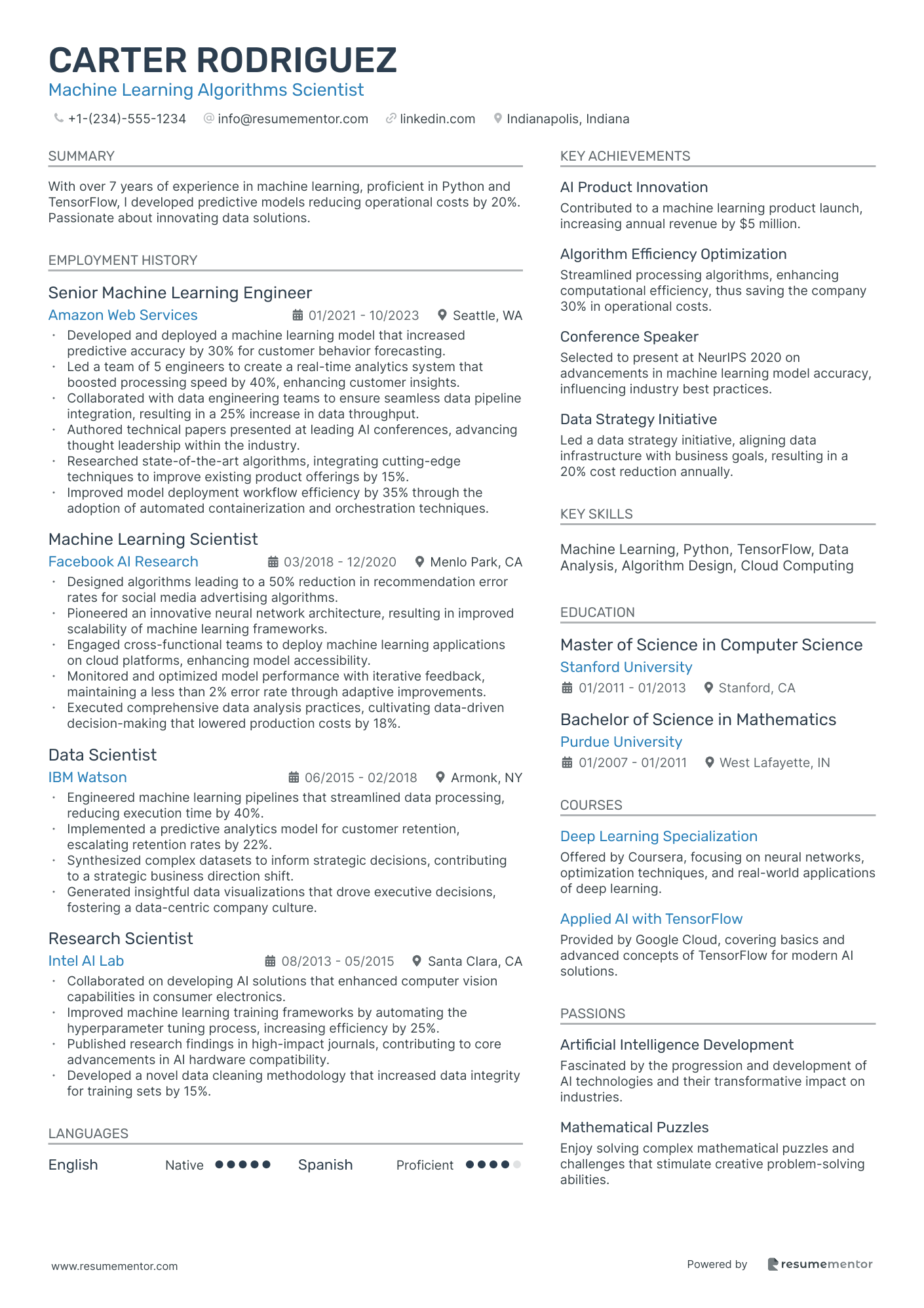
Machine Learning Algorithms Scientist
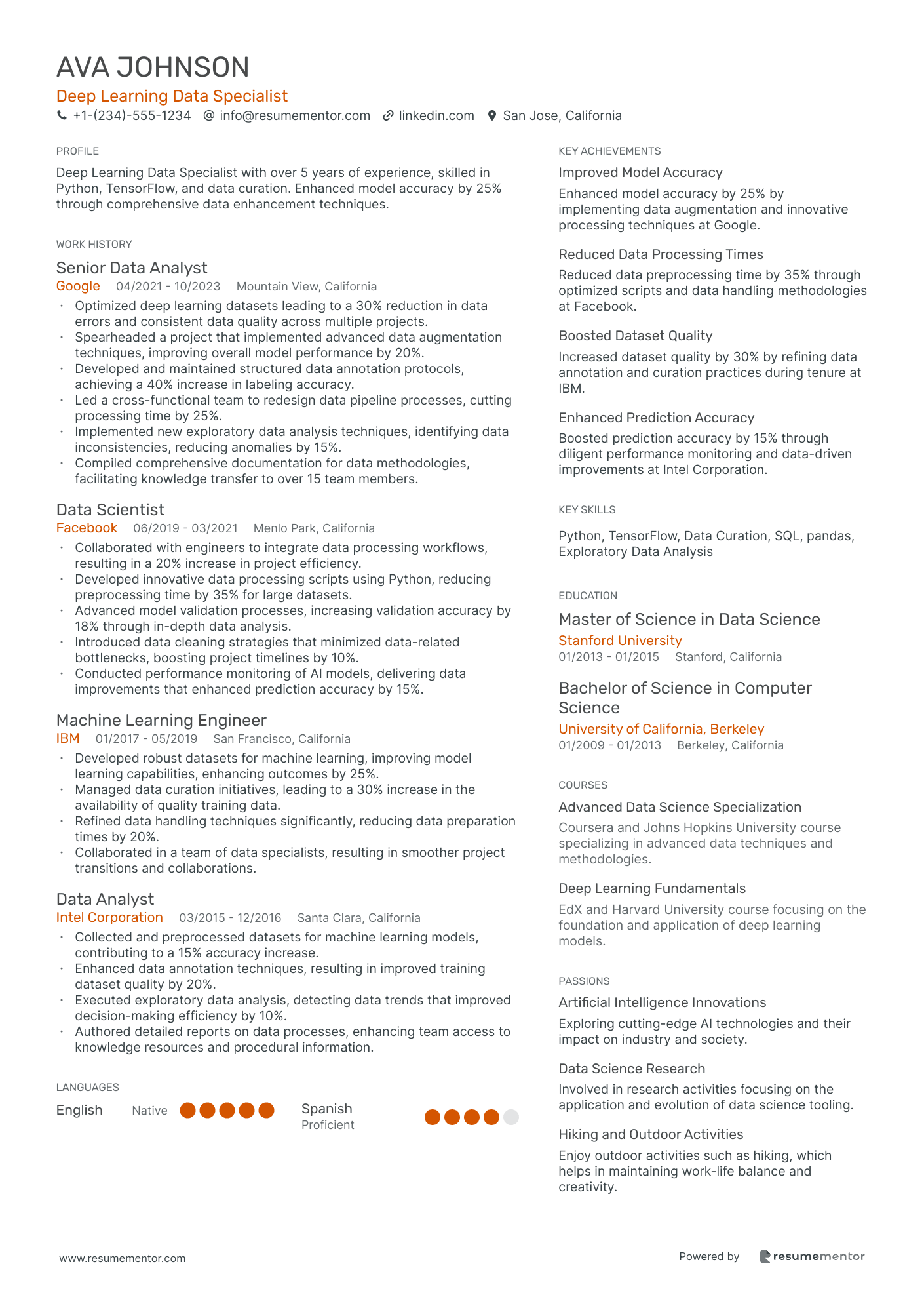
Deep Learning Data Specialist
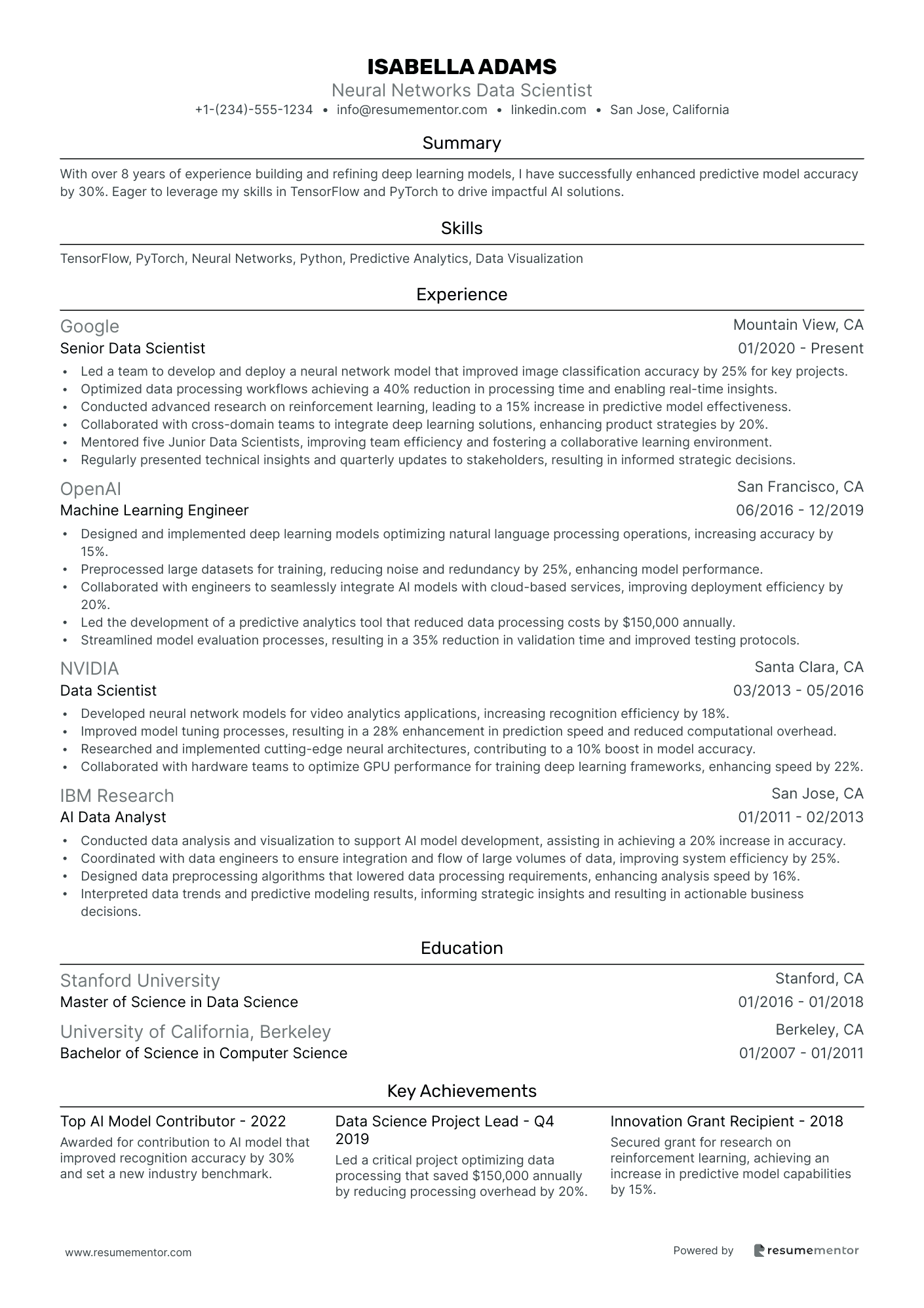
Neural Networks Data Scientist
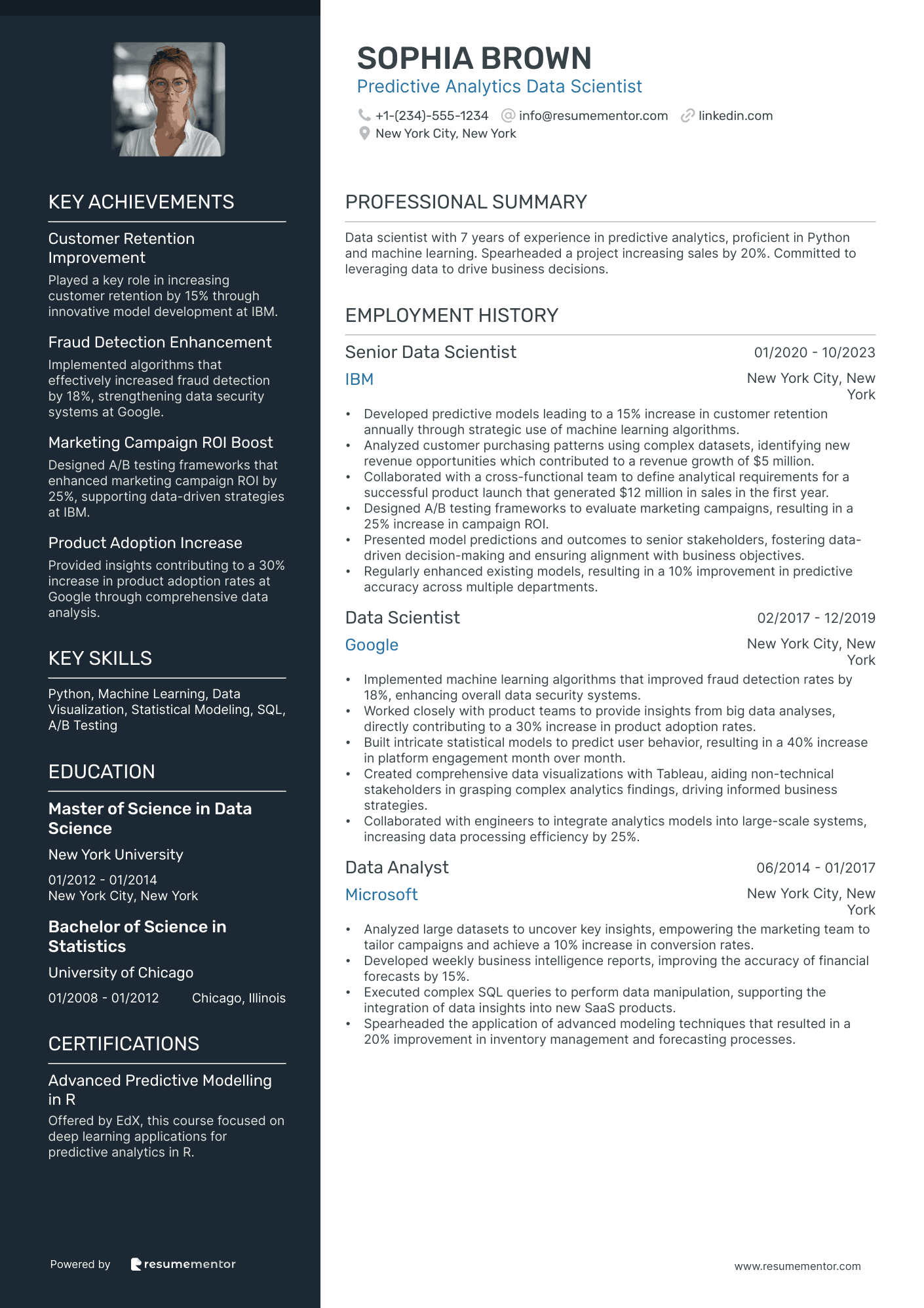
Predictive Analytics Data Scientist
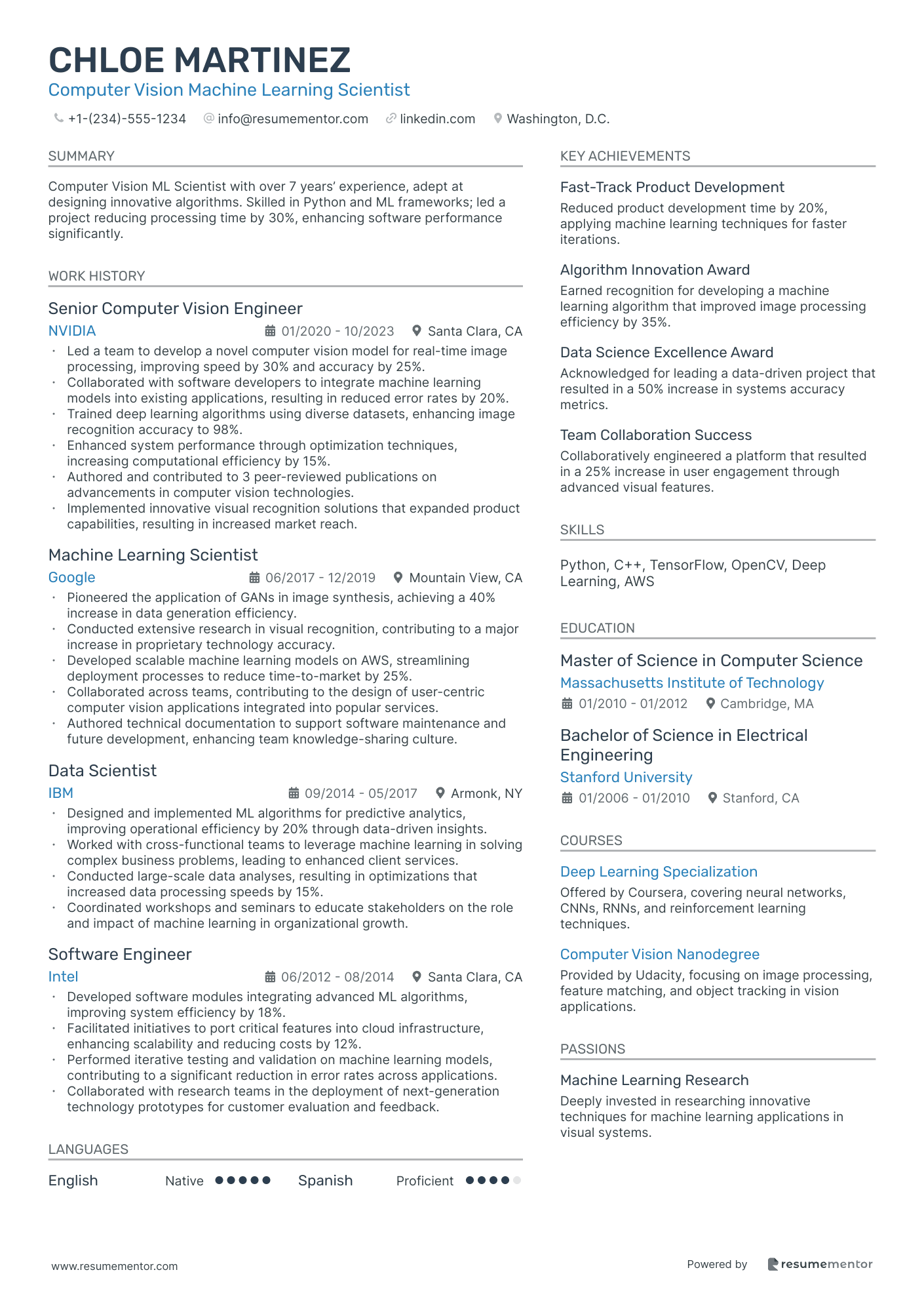
Computer Vision Machine Learning Scientist
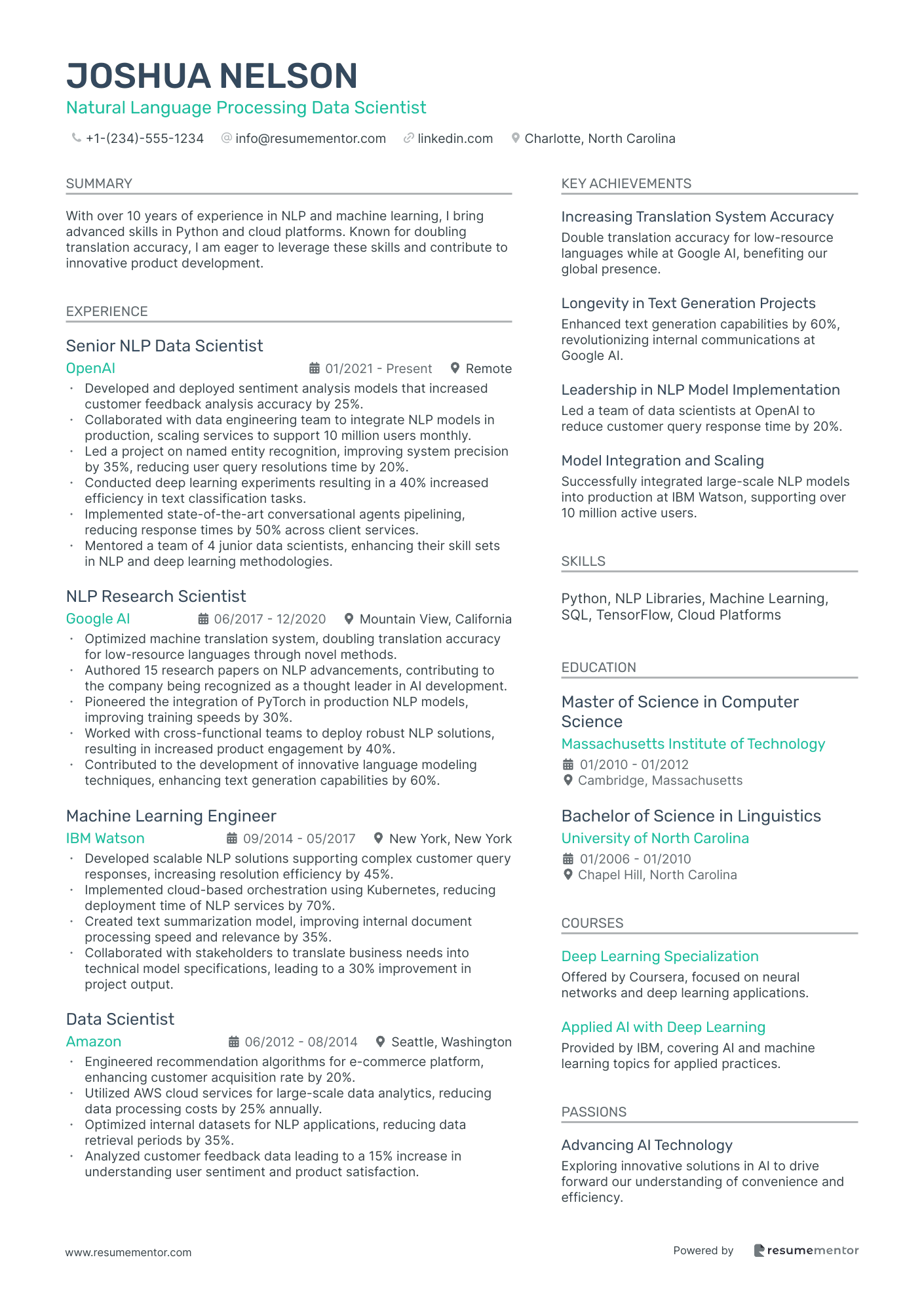
Natural Language Processing Data Scientist
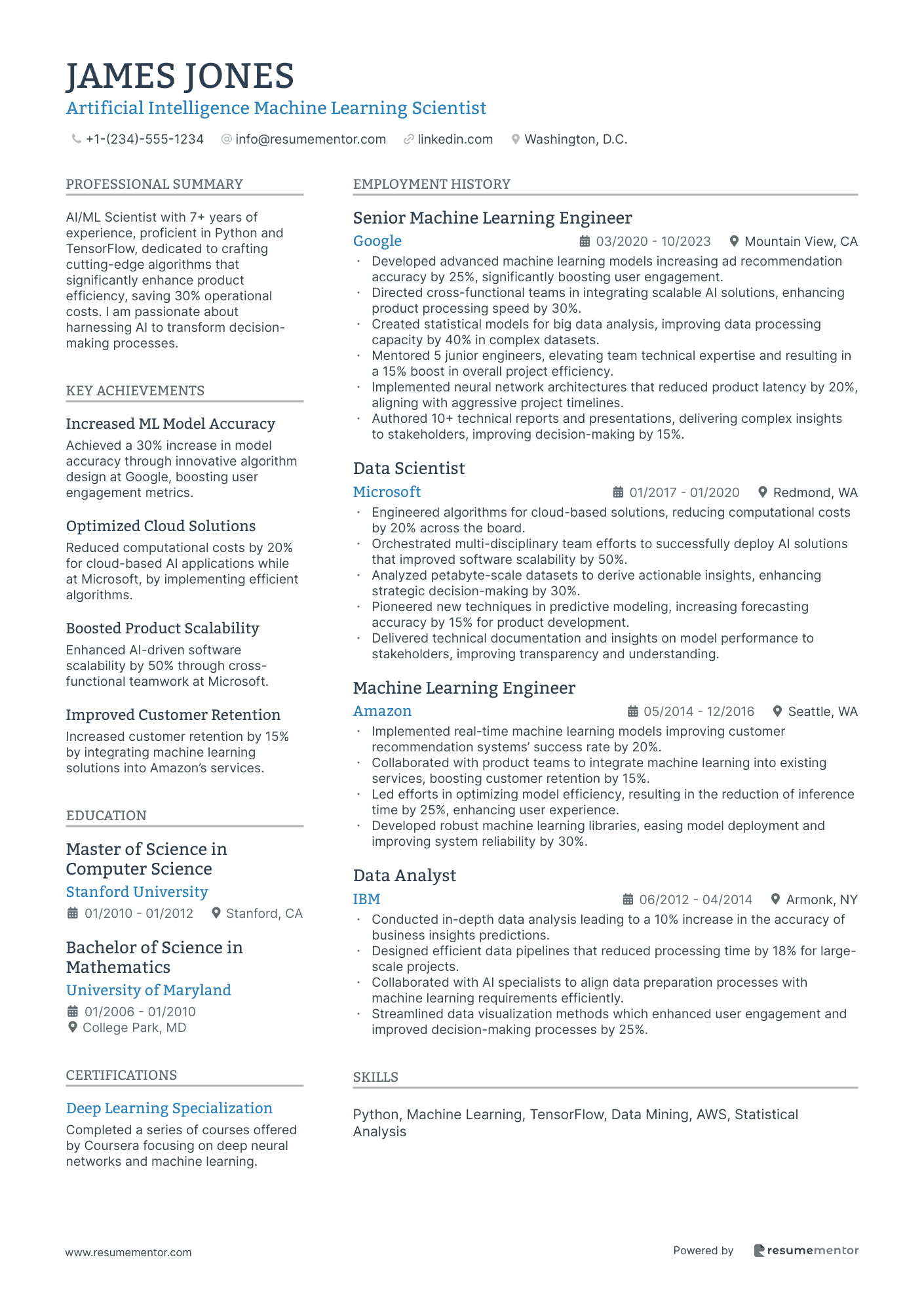
Artificial Intelligence Machine Learning Scientist
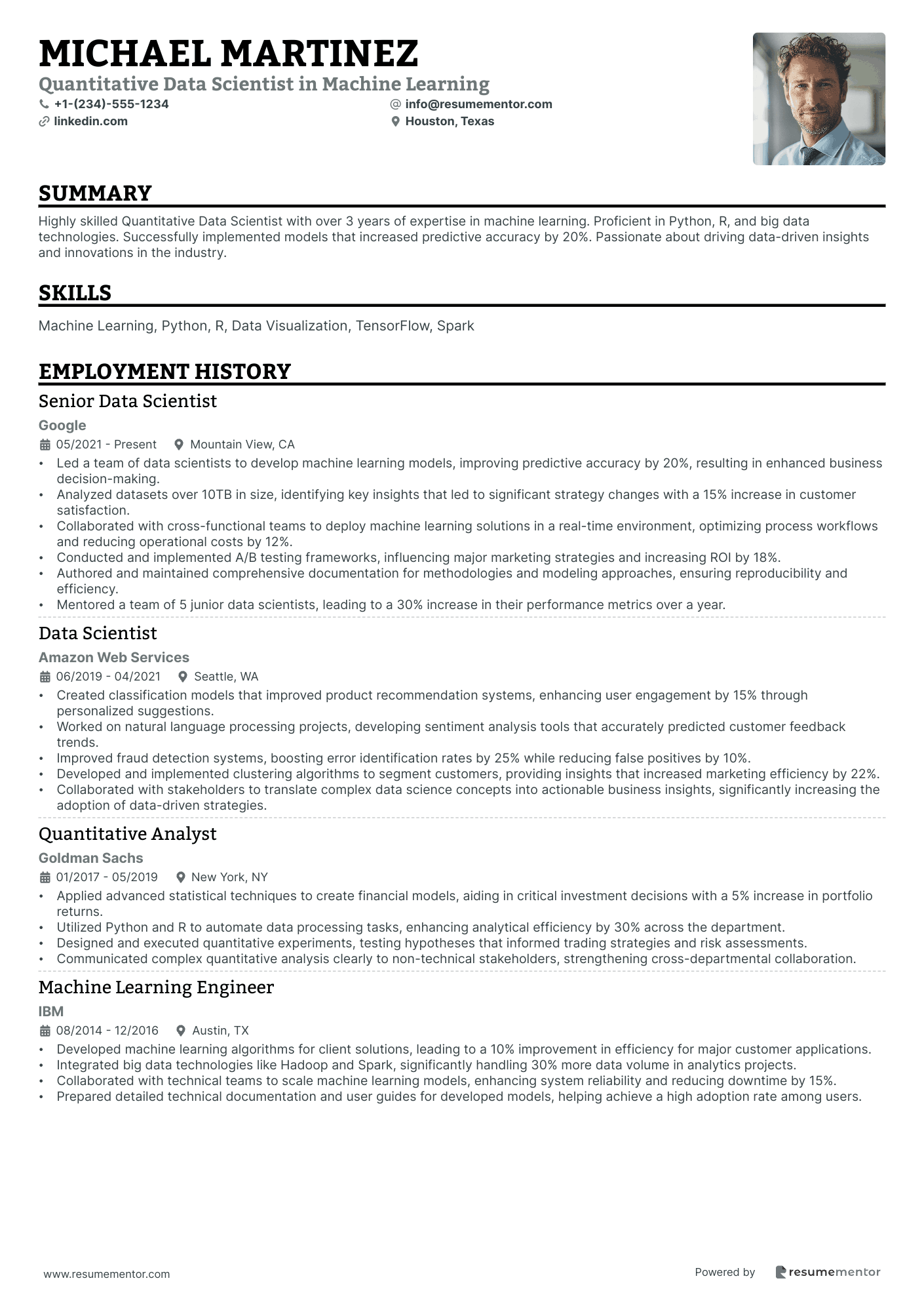
Quantitative Data Scientist in Machine Learning
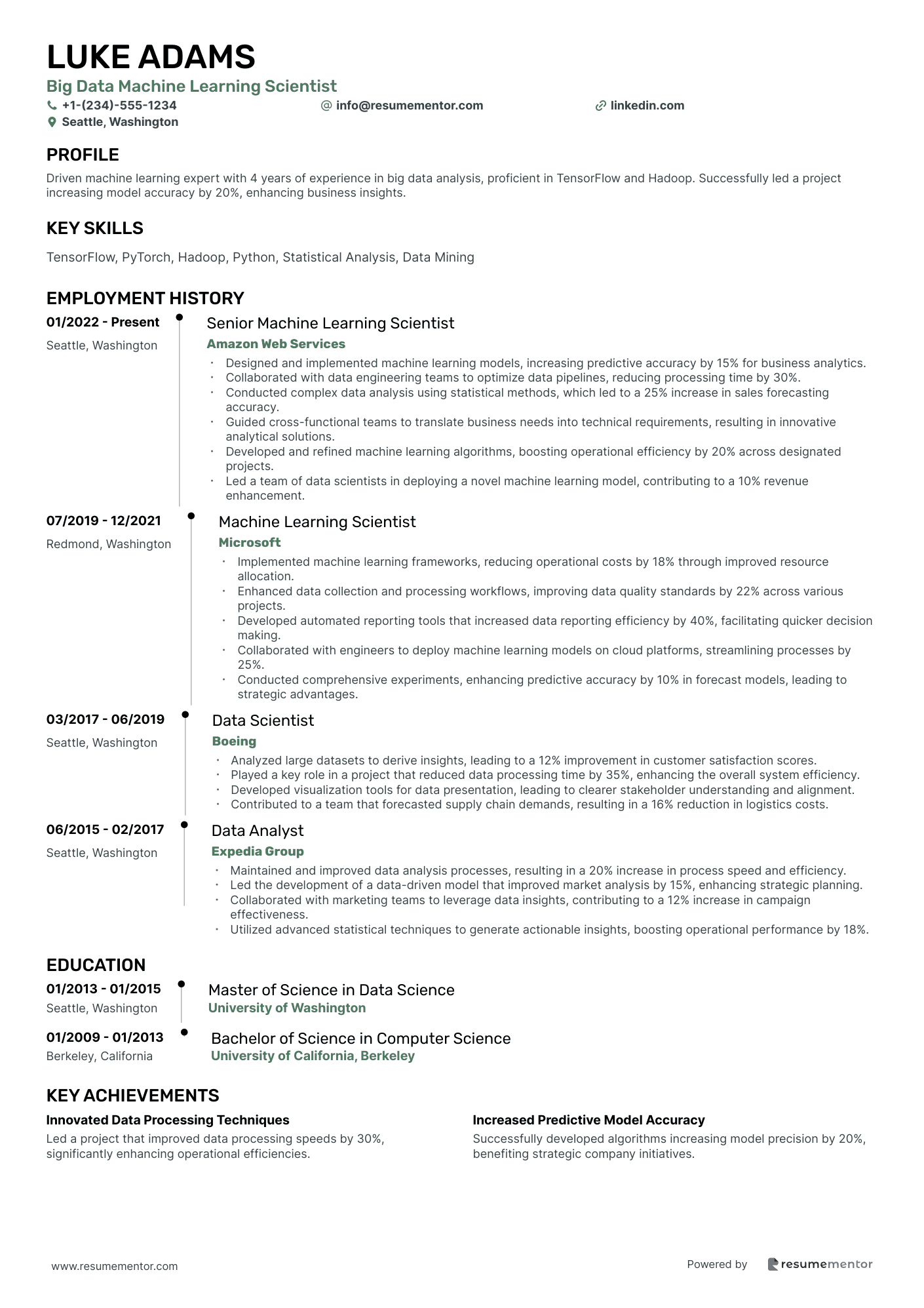
Big Data Machine Learning Scientist

Reinforcement Learning Data Scientist

Machine Learning Algorithms Scientist resume sample
- •Developed and deployed a machine learning model that increased predictive accuracy by 30% for customer behavior forecasting.
- •Led a team of 5 engineers to create a real-time analytics system that boosted processing speed by 40%, enhancing customer insights.
- •Collaborated with data engineering teams to ensure seamless data pipeline integration, resulting in a 25% increase in data throughput.
- •Authored technical papers presented at leading AI conferences, advancing thought leadership within the industry.
- •Researched state-of-the-art algorithms, integrating cutting-edge techniques to improve existing product offerings by 15%.
- •Improved model deployment workflow efficiency by 35% through the adoption of automated containerization and orchestration techniques.
- •Designed algorithms leading to a 50% reduction in recommendation error rates for social media advertising algorithms.
- •Pioneered an innovative neural network architecture, resulting in improved scalability of machine learning frameworks.
- •Engaged cross-functional teams to deploy machine learning applications on cloud platforms, enhancing model accessibility.
- •Monitored and optimized model performance with iterative feedback, maintaining a less than 2% error rate through adaptive improvements.
- •Executed comprehensive data analysis practices, cultivating data-driven decision-making that lowered production costs by 18%.
- •Engineered machine learning pipelines that streamlined data processing, reducing execution time by 40%.
- •Implemented a predictive analytics model for customer retention, escalating retention rates by 22%.
- •Synthesized complex datasets to inform strategic decisions, contributing to a strategic business direction shift.
- •Generated insightful data visualizations that drove executive decisions, fostering a data-centric company culture.
- •Collaborated on developing AI solutions that enhanced computer vision capabilities in consumer electronics.
- •Improved machine learning training frameworks by automating the hyperparameter tuning process, increasing efficiency by 25%.
- •Published research findings in high-impact journals, contributing to core advancements in AI hardware compatibility.
- •Developed a novel data cleaning methodology that increased data integrity for training sets by 15%.
Deep Learning Data Specialist resume sample
- •Optimized deep learning datasets leading to a 30% reduction in data errors and consistent data quality across multiple projects.
- •Spearheaded a project that implemented advanced data augmentation techniques, improving overall model performance by 20%.
- •Developed and maintained structured data annotation protocols, achieving a 40% increase in labeling accuracy.
- •Led a cross-functional team to redesign data pipeline processes, cutting processing time by 25%.
- •Implemented new exploratory data analysis techniques, identifying data inconsistencies, reducing anomalies by 15%.
- •Compiled comprehensive documentation for data methodologies, facilitating knowledge transfer to over 15 team members.
- •Collaborated with engineers to integrate data processing workflows, resulting in a 20% increase in project efficiency.
- •Developed innovative data processing scripts using Python, reducing preprocessing time by 35% for large datasets.
- •Advanced model validation processes, increasing validation accuracy by 18% through in-depth data analysis.
- •Introduced data cleaning strategies that minimized data-related bottlenecks, boosting project timelines by 10%.
- •Conducted performance monitoring of AI models, delivering data improvements that enhanced prediction accuracy by 15%.
- •Developed robust datasets for machine learning, improving model learning capabilities, enhancing outcomes by 25%.
- •Managed data curation initiatives, leading to a 30% increase in the availability of quality training data.
- •Refined data handling techniques significantly, reducing data preparation times by 20%.
- •Collaborated in a team of data specialists, resulting in smoother project transitions and collaborations.
- •Collected and preprocessed datasets for machine learning models, contributing to a 15% accuracy increase.
- •Enhanced data annotation techniques, resulting in improved training dataset quality by 20%.
- •Executed exploratory data analysis, detecting data trends that improved decision-making efficiency by 10%.
- •Authored detailed reports on data processes, enhancing team access to knowledge resources and procedural information.
Neural Networks Data Scientist resume sample
- •Led a team to develop and deploy a neural network model that improved image classification accuracy by 25% for key projects.
- •Optimized data processing workflows achieving a 40% reduction in processing time and enabling real-time insights.
- •Conducted advanced research on reinforcement learning, leading to a 15% increase in predictive model effectiveness.
- •Collaborated with cross-domain teams to integrate deep learning solutions, enhancing product strategies by 20%.
- •Mentored five Junior Data Scientists, improving team efficiency and fostering a collaborative learning environment.
- •Regularly presented technical insights and quarterly updates to stakeholders, resulting in informed strategic decisions.
- •Designed and implemented deep learning models optimizing natural language processing operations, increasing accuracy by 15%.
- •Preprocessed large datasets for training, reducing noise and redundancy by 25%, enhancing model performance.
- •Collaborated with engineers to seamlessly integrate AI models with cloud-based services, improving deployment efficiency by 20%.
- •Led the development of a predictive analytics tool that reduced data processing costs by $150,000 annually.
- •Streamlined model evaluation processes, resulting in a 35% reduction in validation time and improved testing protocols.
- •Developed neural network models for video analytics applications, increasing recognition efficiency by 18%.
- •Improved model tuning processes, resulting in a 28% enhancement in prediction speed and reduced computational overhead.
- •Researched and implemented cutting-edge neural architectures, contributing to a 10% boost in model accuracy.
- •Collaborated with hardware teams to optimize GPU performance for training deep learning frameworks, enhancing speed by 22%.
- •Conducted data analysis and visualization to support AI model development, assisting in achieving a 20% increase in accuracy.
- •Coordinated with data engineers to ensure integration and flow of large volumes of data, improving system efficiency by 25%.
- •Designed data preprocessing algorithms that lowered data processing requirements, enhancing analysis speed by 16%.
- •Interpreted data trends and predictive modeling results, informing strategic insights and resulting in actionable business decisions.
Predictive Analytics Data Scientist resume sample
- •Developed predictive models leading to a 15% increase in customer retention annually through strategic use of machine learning algorithms.
- •Analyzed customer purchasing patterns using complex datasets, identifying new revenue opportunities which contributed to a revenue growth of $5 million.
- •Collaborated with a cross-functional team to define analytical requirements for a successful product launch that generated $12 million in sales in the first year.
- •Designed A/B testing frameworks to evaluate marketing campaigns, resulting in a 25% increase in campaign ROI.
- •Presented model predictions and outcomes to senior stakeholders, fostering data-driven decision-making and ensuring alignment with business objectives.
- •Regularly enhanced existing models, resulting in a 10% improvement in predictive accuracy across multiple departments.
- •Implemented machine learning algorithms that improved fraud detection rates by 18%, enhancing overall data security systems.
- •Worked closely with product teams to provide insights from big data analyses, directly contributing to a 30% increase in product adoption rates.
- •Built intricate statistical models to predict user behavior, resulting in a 40% increase in platform engagement month over month.
- •Created comprehensive data visualizations with Tableau, aiding non-technical stakeholders in grasping complex analytics findings, driving informed business strategies.
- •Collaborated with engineers to integrate analytics models into large-scale systems, increasing data processing efficiency by 25%.
- •Analyzed large datasets to uncover key insights, empowering the marketing team to tailor campaigns and achieve a 10% increase in conversion rates.
- •Developed weekly business intelligence reports, improving the accuracy of financial forecasts by 15%.
- •Executed complex SQL queries to perform data manipulation, supporting the integration of data insights into new SaaS products.
- •Spearheaded the application of advanced modeling techniques that resulted in a 20% improvement in inventory management and forecasting processes.
- •Conducted in-depth analysis to support SAP implementation projects, contributing to a 5,000-hour reduction in project rollout time.
- •Collaborated with the IT department to streamline data collection processes, resulting in a 30% boost in operational efficiency.
- •Developed dashboards using Power BI, which improved the decision-making speed of the executive team by 50%.
- •Identified key data trends contributing to the development of new business strategies that enhanced client profitability by 12%.
Computer Vision Machine Learning Scientist resume sample
- •Led a team to develop a novel computer vision model for real-time image processing, improving speed by 30% and accuracy by 25%.
- •Collaborated with software developers to integrate machine learning models into existing applications, resulting in reduced error rates by 20%.
- •Trained deep learning algorithms using diverse datasets, enhancing image recognition accuracy to 98%.
- •Enhanced system performance through optimization techniques, increasing computational efficiency by 15%.
- •Authored and contributed to 3 peer-reviewed publications on advancements in computer vision technologies.
- •Implemented innovative visual recognition solutions that expanded product capabilities, resulting in increased market reach.
- •Pioneered the application of GANs in image synthesis, achieving a 40% increase in data generation efficiency.
- •Conducted extensive research in visual recognition, contributing to a major increase in proprietary technology accuracy.
- •Developed scalable machine learning models on AWS, streamlining deployment processes to reduce time-to-market by 25%.
- •Collaborated across teams, contributing to the design of user-centric computer vision applications integrated into popular services.
- •Authored technical documentation to support software maintenance and future development, enhancing team knowledge-sharing culture.
- •Designed and implemented ML algorithms for predictive analytics, improving operational efficiency by 20% through data-driven insights.
- •Worked with cross-functional teams to leverage machine learning in solving complex business problems, leading to enhanced client services.
- •Conducted large-scale data analyses, resulting in optimizations that increased data processing speeds by 15%.
- •Coordinated workshops and seminars to educate stakeholders on the role and impact of machine learning in organizational growth.
- •Developed software modules integrating advanced ML algorithms, improving system efficiency by 18%.
- •Facilitated initiatives to port critical features into cloud infrastructure, enhancing scalability and reducing costs by 12%.
- •Performed iterative testing and validation on machine learning models, contributing to a significant reduction in error rates across applications.
- •Collaborated with research teams in the deployment of next-generation technology prototypes for customer evaluation and feedback.
Natural Language Processing Data Scientist resume sample
- •Developed and deployed sentiment analysis models that increased customer feedback analysis accuracy by 25%.
- •Collaborated with data engineering team to integrate NLP models in production, scaling services to support 10 million users monthly.
- •Led a project on named entity recognition, improving system precision by 35%, reducing user query resolutions time by 20%.
- •Conducted deep learning experiments resulting in a 40% increased efficiency in text classification tasks.
- •Implemented state-of-the-art conversational agents pipelining, reducing response times by 50% across client services.
- •Mentored a team of 4 junior data scientists, enhancing their skill sets in NLP and deep learning methodologies.
- •Optimized machine translation system, doubling translation accuracy for low-resource languages through novel methods.
- •Authored 15 research papers on NLP advancements, contributing to the company being recognized as a thought leader in AI development.
- •Pioneered the integration of PyTorch in production NLP models, improving training speeds by 30%.
- •Worked with cross-functional teams to deploy robust NLP solutions, resulting in increased product engagement by 40%.
- •Contributed to the development of innovative language modeling techniques, enhancing text generation capabilities by 60%.
- •Developed scalable NLP solutions supporting complex customer query responses, increasing resolution efficiency by 45%.
- •Implemented cloud-based orchestration using Kubernetes, reducing deployment time of NLP services by 70%.
- •Created text summarization model, improving internal document processing speed and relevance by 35%.
- •Collaborated with stakeholders to translate business needs into technical model specifications, leading to a 30% improvement in project output.
- •Engineered recommendation algorithms for e-commerce platform, enhancing customer acquisition rate by 20%.
- •Utilized AWS cloud services for large-scale data analytics, reducing data processing costs by 25% annually.
- •Optimized internal datasets for NLP applications, reducing data retrieval periods by 35%.
- •Analyzed customer feedback data leading to a 15% increase in understanding user sentiment and product satisfaction.
Artificial Intelligence Machine Learning Scientist resume sample
- •Developed advanced machine learning models increasing ad recommendation accuracy by 25%, significantly boosting user engagement.
- •Directed cross-functional teams in integrating scalable AI solutions, enhancing product processing speed by 30%.
- •Created statistical models for big data analysis, improving data processing capacity by 40% in complex datasets.
- •Mentored 5 junior engineers, elevating team technical expertise and resulting in a 15% boost in overall project efficiency.
- •Implemented neural network architectures that reduced product latency by 20%, aligning with aggressive project timelines.
- •Authored 10+ technical reports and presentations, delivering complex insights to stakeholders, improving decision-making by 15%.
- •Engineered algorithms for cloud-based solutions, reducing computational costs by 20% across the board.
- •Orchestrated multi-disciplinary team efforts to successfully deploy AI solutions that improved software scalability by 50%.
- •Analyzed petabyte-scale datasets to derive actionable insights, enhancing strategic decision-making by 30%.
- •Pioneered new techniques in predictive modeling, increasing forecasting accuracy by 15% for product development.
- •Delivered technical documentation and insights on model performance to stakeholders, improving transparency and understanding.
- •Implemented real-time machine learning models improving customer recommendation systems’ success rate by 20%.
- •Collaborated with product teams to integrate machine learning into existing services, boosting customer retention by 15%.
- •Led efforts in optimizing model efficiency, resulting in the reduction of inference time by 25%, enhancing user experience.
- •Developed robust machine learning libraries, easing model deployment and improving system reliability by 30%.
- •Conducted in-depth data analysis leading to a 10% increase in the accuracy of business insights predictions.
- •Designed efficient data pipelines that reduced processing time by 18% for large-scale projects.
- •Collaborated with AI specialists to align data preparation processes with machine learning requirements efficiently.
- •Streamlined data visualization methods which enhanced user engagement and improved decision-making processes by 25%.
Quantitative Data Scientist in Machine Learning resume sample
- •Led a team of data scientists to develop machine learning models, improving predictive accuracy by 20%, resulting in enhanced business decision-making.
- •Analyzed datasets over 10TB in size, identifying key insights that led to significant strategy changes with a 15% increase in customer satisfaction.
- •Collaborated with cross-functional teams to deploy machine learning solutions in a real-time environment, optimizing process workflows and reducing operational costs by 12%.
- •Conducted and implemented A/B testing frameworks, influencing major marketing strategies and increasing ROI by 18%.
- •Authored and maintained comprehensive documentation for methodologies and modeling approaches, ensuring reproducibility and efficiency.
- •Mentored a team of 5 junior data scientists, leading to a 30% increase in their performance metrics over a year.
- •Created classification models that improved product recommendation systems, enhancing user engagement by 15% through personalized suggestions.
- •Worked on natural language processing projects, developing sentiment analysis tools that accurately predicted customer feedback trends.
- •Improved fraud detection systems, boosting error identification rates by 25% while reducing false positives by 10%.
- •Developed and implemented clustering algorithms to segment customers, providing insights that increased marketing efficiency by 22%.
- •Collaborated with stakeholders to translate complex data science concepts into actionable business insights, significantly increasing the adoption of data-driven strategies.
- •Applied advanced statistical techniques to create financial models, aiding in critical investment decisions with a 5% increase in portfolio returns.
- •Utilized Python and R to automate data processing tasks, enhancing analytical efficiency by 30% across the department.
- •Designed and executed quantitative experiments, testing hypotheses that informed trading strategies and risk assessments.
- •Communicated complex quantitative analysis clearly to non-technical stakeholders, strengthening cross-departmental collaboration.
- •Developed machine learning algorithms for client solutions, leading to a 10% improvement in efficiency for major customer applications.
- •Integrated big data technologies like Hadoop and Spark, significantly handling 30% more data volume in analytics projects.
- •Collaborated with technical teams to scale machine learning models, enhancing system reliability and reducing downtime by 15%.
- •Prepared detailed technical documentation and user guides for developed models, helping achieve a high adoption rate among users.
Big Data Machine Learning Scientist resume sample
- •Designed and implemented machine learning models, increasing predictive accuracy by 15% for business analytics.
- •Collaborated with data engineering teams to optimize data pipelines, reducing processing time by 30%.
- •Conducted complex data analysis using statistical methods, which led to a 25% increase in sales forecasting accuracy.
- •Guided cross-functional teams to translate business needs into technical requirements, resulting in innovative analytical solutions.
- •Developed and refined machine learning algorithms, boosting operational efficiency by 20% across designated projects.
- •Led a team of data scientists in deploying a novel machine learning model, contributing to a 10% revenue enhancement.
- •Implemented machine learning frameworks, reducing operational costs by 18% through improved resource allocation.
- •Enhanced data collection and processing workflows, improving data quality standards by 22% across various projects.
- •Developed automated reporting tools that increased data reporting efficiency by 40%, facilitating quicker decision making.
- •Collaborated with engineers to deploy machine learning models on cloud platforms, streamlining processes by 25%.
- •Conducted comprehensive experiments, enhancing predictive accuracy by 10% in forecast models, leading to strategic advantages.
- •Analyzed large datasets to derive insights, leading to a 12% improvement in customer satisfaction scores.
- •Played a key role in a project that reduced data processing time by 35%, enhancing the overall system efficiency.
- •Developed visualization tools for data presentation, leading to clearer stakeholder understanding and alignment.
- •Contributed to a team that forecasted supply chain demands, resulting in a 16% reduction in logistics costs.
- •Maintained and improved data analysis processes, resulting in a 20% increase in process speed and efficiency.
- •Led the development of a data-driven model that improved market analysis by 15%, enhancing strategic planning.
- •Collaborated with marketing teams to leverage data insights, contributing to a 12% increase in campaign effectiveness.
- •Utilized advanced statistical techniques to generate actionable insights, boosting operational performance by 18%.
Reinforcement Learning Data Scientist resume sample
- •Designed advanced reinforcement learning algorithms improving recommendation systems efficiency by 25%.
- •Implemented high-performance data preprocessing pipelines with 30% faster computation on large datasets.
- •Collaborated with cross-functional teams, translating complex business strategies into analytical solutions, increasing workflow efficiency by 15%.
- •Guided and mentored a team of 5 junior data scientists, enhancing their understanding of reinforcement learning techniques.
- •Conducted regular experiments to refine model parameters, resulting in a 10% improvement in decision-making accuracy.
- •Provided quarterly presentations to stakeholders, effectively communicating insights that drove strategic business decisions.
- •Streamlined data processing operations, reducing latency by 20% and enhancing model training efficiency.
- •Developed reinforcement learning models that increased ad targeting precision by 18%, significantly boosting customer engagement.
- •Worked closely with product managers to implement machine learning frameworks addressing key user feedback.
- •Maintained an up-to-date understanding of cutting-edge ML research trends to integrate innovative concepts into projects.
- •Authored comprehensive reports detailing model outcomes, which improved stakeholders' decision-making capabilities.
- •Optimized reinforcement learning algorithms tailored to enhance IBM Watson services by 15%.
- •Led simulations and evaluations, boosting predictive accuracy of health diagnostics by 12%.
- •Initiated cross-department collaborations aligning AI solutions with IBM's strategic business objectives.
- •Integrated statistical methods into existing pipelines, improving processing throughput by 10%.
- •Analyzed industrial datasets, uncovering insights that improved manufacturing processes and reduced costs by 8%.
- •Implemented Python tools to automate data collection, increasing overall data analysis efficiency by 15%.
- •Created dashboards for data visualization that streamlined reporting processes and enhanced clarity for executive reviews.
- •Conducted statistical analyses to support decision-making in product development, influencing a key project direction.
In the fast-paced world of machine learning, your resume is more than just a list of jobs—it's your blueprint for landing the perfect role. Successfully translating your expertise and data-driven insights into a compelling resume can feel like decoding a challenging problem. To make a strong impression, highlight your skills and achievements clearly, showcasing your ability to solve complex issues with creativity. Employers need to quickly grasp how you can turn data into actionable predictions and benefit their organization.
A standard resume template can be your guide, helping you organize your talents effectively. By using resume templates, you ensure that your strengths stand out and capture attention. When presenting your experience, focus on the specifics, using precise language and data points. Describe how you've implemented models or enhanced data pipelines, making your accomplishments clear and impactful.
Tailoring your resume to each job is crucial, as it aligns your experience with the specific needs of the role. This personalized approach demonstrates that you're not only qualified but also the perfect fit for their team. With these strategies, your resume transforms from a mere document into a dynamic story of your career in machine learning.
Key Takeaways
- When crafting a machine learning data scientist resume, highlight your ability to solve complex challenges with creativity and data-driven insights, tailoring your experience to align with the specific job role.
- Structure your resume using a standard template that emphasizes skills like Python, R, TensorFlow, and projects that demonstrate your practical applications and achievements in machine learning.
- Employ a chronological format to showcase the progression of your education and work experience, ensuring it looks polished and professional by using modern fonts and saving it as a PDF.
- The experience section should include quantifiable accomplishments with a focus on impactful results, using dynamic, action-oriented language to depict your contributions effectively.
- Include relevant education, certificates, and specialized skills that align with job descriptions, and consider additional sections to display language proficiencies, hobbies, or volunteer work to give a well-rounded representation of your capabilities.
What to focus on when writing your machine learning data scientiest resume
Your machine learning data scientist resume should effectively convey your ability to solve complex challenges using data and algorithms, highlighting how your skills and experience can drive success for an employer.
How to structure your machine learning data scientiest resume
- Contact Information — Begin with your full name, phone number, email address, and LinkedIn profile. These crucial details ensure recruiters can easily reach you, keeping communication open for potential follow-ups or interviews. Keep them prominent at the top of your resume for easy visibility.
- Professional Summary — Present a brief snapshot of your career that emphasizes your strengths in machine learning and data science. This is your chance to hook the recruiter with your most compelling accomplishments and the unique value you bring. Providing a clear overview sets the tone for the rest of your resume, leading recruiters to eagerly explore further.
- Skills — This section should highlight your technical prowess, with skills like Python, R, and TensorFlow being essential mentions. Including specialized techniques, such as natural language processing or deep learning, emphasizes your expertise and offers recruiters a quick view of your capabilities. This builds a natural bridge to your practical applications in the next section.
- Professional Experience — Detail your relevant work history, focusing on roles that have utilized your data science and machine learning expertise. Use bullet points to concisely illustrate your responsibilities and achievements, quantifying successes with statistics like model accuracy improvements or processing efficiency gains. These details reinforce the skills mentioned earlier, providing evidence of your real-world impact.
- Education — This section establishes your academic foundation by listing degrees, institutions, and key coursework. Highlighting any advanced studies or certifications in machine learning underscores your commitment to the field, reflecting your readiness to learn and grow continuously. This segues into providing detailed examples of applying your knowledge in projects.
- Projects — Showcase specific projects where you've applied machine learning techniques, which offers a practical demonstration of your theoretical learning. By describing your role, the technologies used, and the impact of your work, you craft a narrative that ties your skills and experience together in a compelling manner.
Next, we'll cover each resume section in-depth to ensure your resume format is both effective and precise, delivering a comprehensive picture of your capabilities and achievements.
Which resume format to choose
As a machine learning data scientist, crafting a resume that stands out involves a blend of structure, style, and clarity. Starting with the structure, a chronological format is a smart choice. It allows you to effectively showcase the progression of your education and work experiences, essential for illustrating your career path and the depth of your expertise in machine learning.
When it comes to style, choosing the right font can subtly reflect your professionalism. Raleway’s sleek aesthetic or Montserrat’s approachable style can make a big difference in how your resume is perceived. Lato’s polished look can also convey a sense of modernity and sophistication without overpowering your content. These choices help your resume remain visually appealing while ensuring readability, avoiding the outdated feel of more traditional fonts like Arial or Times New Roman.
File type is another critical consideration; always save your resume as a PDF. This step ensures that your formatting remains intact, no matter where or how your document is viewed. A PDF preserves your carefully selected formatting elements, which means your resume looks just as good on a potential employer’s screen as it does on yours.
Lastly, pay attention to the margins, setting them to one inch all around. This not only provides ample white space for easy reading but also helps maintain a clean and organized layout, ensuring that your content doesn't feel cramped or overwhelming. Following these guidelines will help you create a resume that clearly communicates your skills and achievements in machine learning, making a positive impact on potential employers.
How to write a quantifiable resume experience section
The experience section for a machine learning data scientist is vital for highlighting your skills and accomplishments. Start with your most recent job and work backward, focusing on roles from the last 10-15 years or those most relevant to the job at hand. Emphasize quantifiable results to showcase your impact effectively. Use action-oriented language and job titles that clearly define your role in each position. Tailor your resume to the job description, ensuring you spotlight the skills and experiences that align most closely with the role you're targeting. Integrating dynamic words like "implemented," "optimized," and "developed" helps convey your impact powerfully.
- •Implemented a recommendation system, boosting user engagement by 30%.
- •Optimized model training, cutting overhead by 40%.
- •Developed predictive models that reduced customer churn by 25%.
- •Led a team to deploy a real-time fraud detection model.
This section effectively emphasizes your achievements in machine learning, weaving together relevant experiences and quantifiable successes. Each bullet point is crafted to highlight significant impact, enhancing your story with real results that demonstrate your value. By using specific terms like "recommendation system" and "real-time fraud detection," your expertise is immediately clear, showing how you drive innovation and achieve targets. The chronological structure flows smoothly, presenting your most significant contributions first, ensuring the reader immediately grasps the essence of your professional journey. This concise yet detailed approach captures your achievements naturally and seamlessly.
Growth-Focused resume experience section
A growth-focused machine learning data scientist resume experience section should clearly illustrate how your skills and actions have driven company growth. Begin by identifying your key responsibilities and highlighting specific achievements relevant to your role. Use clear language to describe how your efforts directly led to successful project outcomes or strategic advancements. Including metrics will add depth and clarity, as numbers powerfully communicate the impact of your work.
When crafting bullet points, use strong, action-oriented language to lead each one, ensuring a seamless flow from one achievement to another. Focus on how you refined algorithms, boosted efficiency, and tackled complex challenges, demonstrating the tangible results of your work. Favor active phrases like "increased prediction accuracy by 30%" to provide concrete evidence of your contributions. Tailor your entries to align with the expectations of potential employers, ensuring each point clearly showcases the significance of your accomplishments.
Machine Learning Data Scientist
Tech Innovators Ltd.
March 2020 - Present
- Developed machine learning models that increased product recommendation accuracy by 25%, leading to a 15% boost in sales.
- Reduced data processing time by 40% through implementing efficient data pipelines, enhancing team productivity.
- Collaborated with the marketing team to optimize customer targeting strategies, improving campaign responses by 20%.
- Implemented an A/B testing framework that improved decision-making speed for product iterations by 50%.
Innovation-Focused resume experience section
An innovation-focused machine learning data scientist resume experience section should vividly showcase your transformative work and unique problem-solving abilities. Start by highlighting your involvement in creating advanced machine learning models specifically designed to address challenging issues. Emphasize how you've successfully tackled real-world problems and detail the strategies you've implemented to achieve this. By doing so, you bring attention to your impactful achievements and forward-thinking approach that drive change.
When outlining your accomplishments, ensure you focus on results and specific outcomes. Quantifying your successes, such as improving performance metrics or achieving cost savings, adds weight to your narrative. Highlight the new techniques or tools you've introduced and explain how these innovations have benefited your team or organization. By using straightforward and engaging language, you make it easy for employers to see the potential value you offer and how your innovative contributions stand out.
Lead Data Scientist
Tech Innovations Inc.
June 2020 - August 2022
- Developed an AI model that reduced data processing time by 40%, boosting team efficiency.
- Introduced a novel algorithm that increased predictive accuracy for customer behavior by 20%.
- Led a project that implemented machine learning solutions, resulting in a 15% improvement in business performance.
- Collaborated with cross-functional teams to deploy a machine learning model enhancing product recommendation accuracy by 25%.
Training and Development Focused resume experience section
A machine learning-focused data scientist resume experience section should highlight your ability to create transformative training programs while emphasizing your data expertise. Begin by detailing impactful projects where you improved learning outcomes and enhanced processes. Use active verbs to illustrate your contributions, and don't forget to add specific results to underline your achievements. This section should not only reflect your ability to manage complex data projects but also show your leadership in nurturing talent through thoughtful training initiatives.
As you describe each role, focus on the skills and tools that led to significant successes. Connect how you propelled projects forward with any innovative strategies you devised and implemented. Discuss collaborations with diverse teams and detail your contributions to these efforts. The narrative should clearly demonstrate your expertise in deploying machine learning models, while simultaneously fostering talent development through strategic training efforts.
Senior Data Scientist
Tech Innovations Inc.
June 2020 - Present
- Designed and launched a company-wide training program that increased employee proficiency in machine learning tools by 35%
- Collaborated with cross-functional teams to incorporate feedback and ensure training materials meet diverse employee needs
- Implemented a metrics-driven approach to assess training effectiveness, resulting in a 40% rise in participant engagement
- Led workshops and seminars that boosted team familiarity with machine learning innovations, enhancing project quality
Industry-Specific Focus resume experience section
A machine learning-focused data scientist resume experience section should clearly demonstrate how you've applied your expertise to tackle real-world challenges in specific industries like finance, healthcare, or e-commerce. Begin by highlighting key projects where you employed machine learning models, providing details about your role, the tools you used, and the impact your work had on the business. By using active language, you can clearly convey your skills and emphasize achievements with relevant metrics, painting a vivid picture of your contributions. Keep your descriptions concise, using quantifiable results to effectively illustrate the value you added.
Tailor each entry to align with the industry you're targeting, showing how effectively your experience translates across different contexts. This approach not only illustrates your expertise but also ensures your resume resonates with the specific roles you’re pursuing. Ensure each bullet point highlights a distinct aspect of your experience, ensuring your resume is both memorable and relevant.
Machine Learning Engineer
Modern Health Solutions
June 2020 - Present
- Increased patient diagnosis accuracy by 20% through advanced predictive models.
- Efficiently analyzed medical records using natural language processing techniques.
- Collaborated with cross-functional teams to blend ML solutions into hospital systems.
- Cut readmission rates by 15% with enhanced data analysis practices.
Write your machine learning data scientiest resume summary section
A machine learning-focused data scientist resume summary should succinctly convey your expertise, skills, and achievements to make a strong first impression. When applying for a mid to senior-level position, a well-written summary is crucial, while a resume objective might be more fitting for entry-level roles as it highlights your career goals and alignment with the job. Consider the following example for a machine learning data scientist:
This summary stands out because it effectively highlights specific skills and achievements, seamlessly interweaving your technical expertise and project success. By mentioning programming languages and software, you demonstrate your technical proficiency, which is essential for employers. Emphasizing your ability to deliver results and solutions, the summary offers potential employers a clear idea of your impact. The action-oriented language, like "results-driven" and "led projects," further conveys confidence and initiative, pulling the summary together. Whether crafting a summary or an objective, both should offer a clear, concise snapshot of your professional identity. While a summary showcases experience and skills—ideal for seasoned professionals—an objective looks forward and can be suited for entry-level candidates, maintaining focus on tangible outcomes and clear skills.
Listing your machine learning data scientiest skills on your resume
A skills-focused machine learning data scientist resume should clearly highlight both technical abilities and interpersonal strengths. You can choose to present your skills in a dedicated section or integrate them into other parts of your resume, like your experience or summary. Showcasing soft skills such as problem-solving and communication is important, as they demonstrate your ability beyond technical tasks. Hard skills are your concrete, teachable abilities, like mastering programming languages and data analysis tools.
Incorporating your skills as keywords throughout your resume helps recruiters and applicant tracking systems quickly identify your qualifications. By ensuring that your listed skills align with job descriptions and industry expectations, you create a strong match for potential opportunities.
To effectively showcase your competencies, consider this example of a standalone skills section, which is tailored for a machine learning data scientist:
This skills section works well because it directly highlights the essential technical skills for your role, demonstrating your expertise in tools like Python and TensorFlow. By listing a diverse set of skills, you show versatility and adaptability, which are crucial in the evolving field of machine learning.
Best hard skills to feature on your machine learning data scientist resume
Your hard skills should convey your ability to manage data, build models, and utilize core tools effectively. These in-demand skills include:
Hard Skills
- Python Programming
- R Programming
- TensorFlow
- Machine Learning Algorithms
- Data Analysis
- Statistical Modeling
- SQL
- Hadoop
- Spark
- Natural Language Processing
- Computer Vision
- Neural Networks
- Deep Learning
- Big Data Tools
- Data Visualization
Best soft skills to feature on your machine learning data scientist resume
Soft skills reflect your ability to work well with others and tackle complex challenges. Important soft skills to showcase are:
By following these guidelines, you'll create a resume that effectively highlights your skills, making you a strong candidate in the field of machine learning data science.
Soft Skills
- Problem Solving
- Communication
- Teamwork
- Critical Thinking
- Adaptability
- Time Management
- Creativity
- Analytical Thinking
- Attention to Detail
- Leadership
- Result-Orientation
- Empathy
- Conflict Resolution
- Decision Making
- Negotiation Skills
How to include your education on your resume
An education section is a crucial part of your resume, especially for a machine learning data scientist role. Make sure to include only relevant education that aligns with the job you're applying for. Anything irrelevant can clutter your resume and distract from your qualifications. When listing your degree, be clear about the level, field, and any notable achievements like cum laude honors. Including your GPA can be a good idea if it is strong, typically 3.5 or higher, and it should be formatted clearly, like "GPA: 3.8/4.0". If you're still unsure how this should look, consider the following examples for guidance.
The second example is what you should aim for. It clearly shows a relevant degree for a data scientist, highlights academic excellence with "cum laude" honors, and includes a strong GPA. This approach demonstrates your qualifications clearly and directly for your targeted position.
How to include machine learning data scientiest certificates on your resume
Including a certificates section in your machine learning data scientist resume is crucial. It shows your credentials and commitment to continuous learning. Certificates can also be included in the header for quick viewing. List the name of the certificate, include the date you received it, and add the issuing organization.
A good example of a certificates section demonstrates relevant and recent achievements:
This example is good because it highlights certificates from reputable sources and shows specialization in relevant areas. Each certificate is clearly dated and attributed to a recognized organization. This layout ensures that prospective employers can quickly see your qualifications. Use this format to keep your certificates section concise and impactful.
Extra sections to include in your machine learning data scientiest resume
Enhancing a machine learning data scientist's resume with additional sections can highlight unique skills and interests, making the application stand out to potential employers. Including various aspects of your life can paint a well-rounded picture of who you are beyond your technical abilities.
Language section — List languages you speak, indicating your proficiency level; this showcases your capability to work in diverse environments. Knowing multiple languages can demonstrate your adaptability in global teams.
Hobbies and interests section — Mention activities like chess or coding competitions, showing you engage in analytical thinking even in your free time. This helps illustrate your passion for problem-solving and continuous learning.
Volunteer work section — Highlight your involvement in programs like tutoring underprivileged students in math, proving your commitment to community development. Employers value candidates who contribute positively to society and possess strong ethics.
Books section — Share your recent reads, especially those on machine learning or data science, showing your dedication to staying current in your field. This can also provide conversation starters during interviews, demonstrating both your knowledge and enthusiasm for your profession.
Incorporating these sections effectively can give a fuller picture of your personality, interests, and values, making your resume more appealing to potential employers.
In Conclusion
In conclusion, crafting a standout resume as a machine learning data scientist involves a careful blend of clarity, precision, and personalization. You need to present your technical and interpersonal skills effectively, ensuring they align with industry standards and job descriptions. Starting with a structured format, such as the chronological one, can highlight your career progression and technical prowess. Remember to use clear, action-oriented language throughout your resume, showcasing your contributions with quantifiable achievements. Each section, from your professional experience to your educational background and certifications, should paint a vivid picture of your journey and qualifications. By highlighting your hard skills in programming and data management, alongside soft skills like problem-solving and teamwork, you make a compelling case to potential employers. Additional sections, like languages spoken or volunteer work, can provide a more comprehensive view of who you are and the unique value you bring. The right choice of fonts, like Raleway or Montserrat, contributes to a professional presentation, while saving your resume as a PDF ensures consistent formatting. Tailoring your resume for each role you apply for underscores your suitability and dedication, transforming it into a dynamic narrative of your career in machine learning. By following these strategies, your resume becomes a strong tool that clearly communicates your capabilities and sets you apart in this competitive field.
Related Articles

Continue Reading
Check more recommended readings to get the job of your dreams.
Resume
Resources
Tools
© 2025. All rights reserved.
Made with love by people who care.

